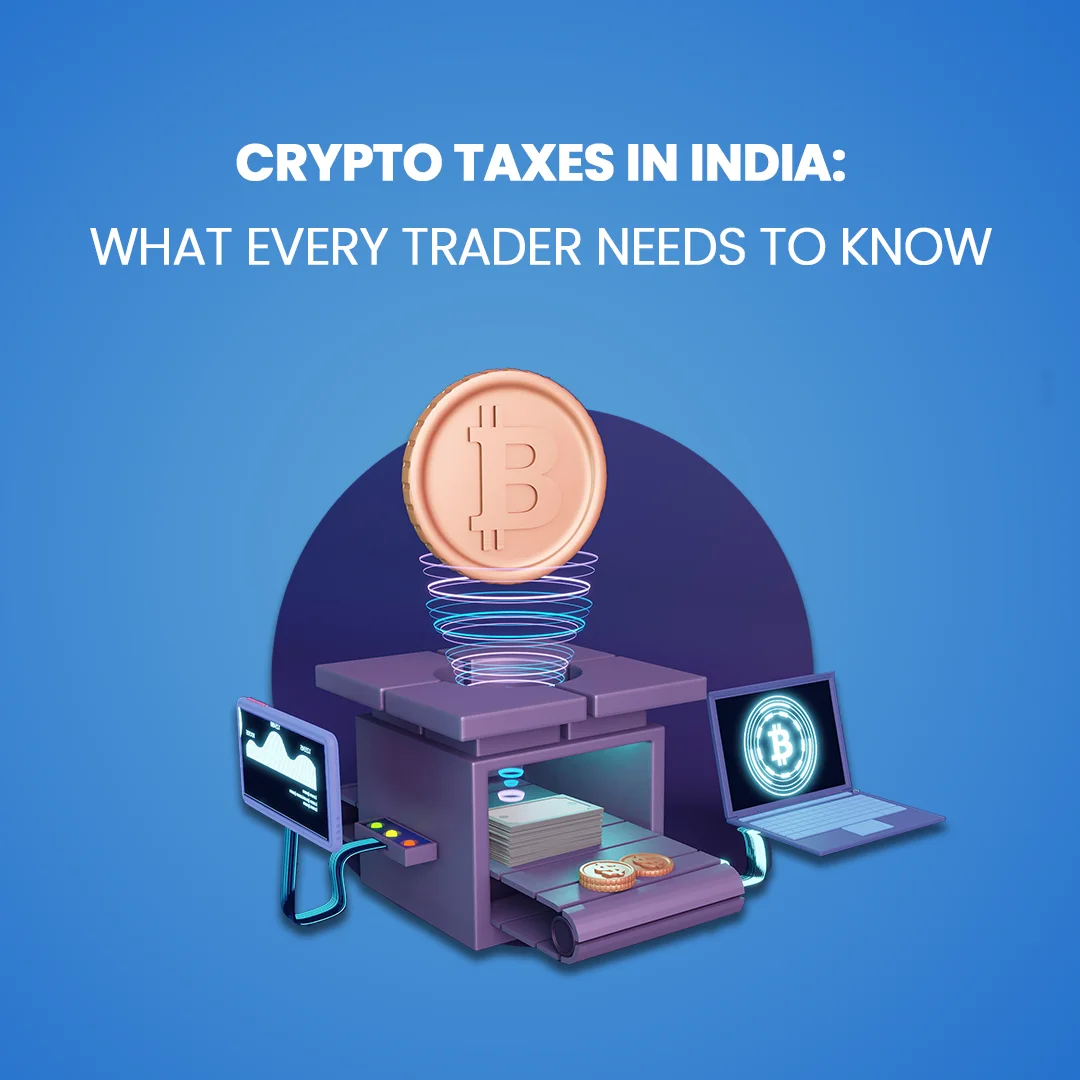

Advancements with Investments
Crypto trading is not new anymore and is becoming synonymous with investments. No matter where you are in life, in today’s era, making wise investments and earning money the smart way is essential for everyone. It is just not about keeping your head above water and meeting expenses; it is equally about forging a secure future and fostering better foundations for advancement.
Whether your goal is saving up for larger life goals like expending in property, securing money for post-retirement life, or just striving for the much-deserved financial freedom, investing the right way will always have your back.
With enhancing your wealth portfolio over time to lend protection to you against any unforeseen events, making smart investment choices guarantees a better lifestyle.
In the modern era, achieving mental peace with long-term financial success that promises security requires one to have a strong understanding of both earning and investing.
Unfolding the Indian Cryptocurrency enthusiasm
India’s cryptocurrency trading industry is expanding incredibly quickly!
An increasing number of Indians are becoming quite interested in investing and accumulating wealth when it comes to personal finance.
Although people have always relied on the stock market, the emergence of cryptocurrencies is generating a lot of excitement!
People now have new chances to increase the size of their financial portfolios because of blockchain technology.
It is amazing to learn that there are currently 100 million+ cryptocurrency users in India, and the user base continues to expand further! This demonstrates the immense excitement and potential that surrounds the cryptocurrency market.
If you are curiosity-driven, with this article you have everything you need to sprint into the fascinating Indian Crypto space.
Cryptocurrency’s growing fame
Cryptocurrency has had its share of fame. Its importance is deep-rooted, and its meaning goes far beyond the term ‘digital money.’ Being known to the world as a powerful growth tool, the world of crypto is on its way to successfully changing a number of business sectors, including finance, healthcare, etc.
Even though cryptocurrencies are widely known, very few people really understand their fundamentals. The crypto experts are of the opinion that people, whether trading already or not, must take out time to get a better hold of this subject.
Want to know how cryptocurrency works?
Cryptocurrency, unlike traditional money, does not need to be verified by central banks or other intermediaries. Being a digital currency, its transactions can be confirmed on a distributed ledger known as a blockchain using encryption.
The original cryptocurrency known as Bitcoin was developed by an anonymous developer, Satoshi Nakamoto, in 2009. Ever since, many digital currencies have been introduced in the virtual world.
Blockchain- the foremost groundwork maker
Blockchain is the fundamental technology behind the functioning of cryptocurrencies. This solid technology is designed to resolve the “doubling up dilemma,” in the world of crypto by fazing digital currencies from being cloned or spent twice fraudulently.
The verification of exchanges and financial settlements has historically been guaranteed by the global financial system, but blockchain technology allows transaction legitimacy to cryptocurrencies by making way for them to function independently of central banks. Blockchain prevents modifications since it is designed to support the unalterable nature of transactions.
Is it legalized to trade crypto in India?
Traders can buy, sell, or hold digital assets such as Bitcoin or Ethereum openly; cryptocurrency, therefore, is not illegal in India. However, it must be noted that they have not been given official legal status as a means of legal financial system or currency that can be used for ordinary, daily transactions.
The Government of India is on the path to devising regulatory guidelines that would control risks and offer clarity regarding the use of cryptocurrencies.
In the past, there were many uncertainties that emerged around trading digital assets after a bill titled ‘The Cryptocurrency and Regulation of Official Digital Currency’ in the year 2021 was revealed. This bill indicated a ban on private cryptocurrencies.
Despite this irregularity and ambiguity faced by Indian traders, many positive likelihoods do emerge as the crypto supportive initiatives were seen by the government. One of the initiatives, viz., the Telangana Web3 Sandbox, proves the growing interest of the authoritative bodies in blockchain technology. This clearly indicates the future possibilities and friendlier integration of cryptocurrencies into the nation’s financial system.
The crypto regulations in the Indian markets are kept highly uncertain, and the digital asset market is quite evidently highly volatile.
The threats of scams and security breaches are modest. A higher velocity of risks can be felt and expected as more and more traders come into the picture and invest in blockchain technology.
There are ways to curb the risks and online thefts; however, it is an investor’s responsibility to be informed and cautious at all times.
Focusing on Crypto Trading and tax regulations in India
For a trader in India, having clarity about tax regulations helps in ensuring compliance and avoiding surprises in trading or investing in crypto assets.
The Indian government introduced definite rules for the taxation of crypto in the financial budget of 2022. Here’s everything you need to know:
Under Section 115BBH of the Income Tax Act, 30% tax is levied along with a 4% cess on income obtained from transferring cryptocoins or any other VDA.
Section 194S: TDS @ 1% on the transactions exceeding ₹ 10,000/- (or ₹ 50,000/- in some cases) shall be deducted from July 1st, 2022.
The taxation falls under the class of investors ranging from private to commercial, without distinguishing between gains from short- and long-term investment.
When trading on an Indian exchange, the exchange itself will deduct the TDS on one’s behalf without the trader having to get in the formalities or procedures.
How do you decide which platform is right for you to carry Crypto transactions?
As a trader, you would have to do your homework in order to recognize which crypto exchange works the best for the kind and volume of transactions you intend to make. You will likely have to benchmark your exchange on the basis of multi-variant factors.
Below are ten parameters that will assist you in taking a close look at and opting for a platform that best suits your crypto needs:
Basic and Advanced Trading Features
The exchange should incorporate various types of trading possibilities within its marketplace platform-from basic ones, for novices, to charting, stop-loss orders, and market indicators for professional traders. A good exchange will thus meet the requirements of everyone.
Margin Trading and Crypto Lending Services
Margin trading enables users to leverage positions that may increase profitability but also amplifies risks. Crypto lending services complement the offering, enabling users to lend or borrow cryptocurrencies to receive interest and further empower active traders and investors into passive income streams.
Educational Resources
A competitive exchange will also provide educational resources, such as tutorials and guides on how to understand the subtleties of cryptocurrency trading. Such resources could include everything from a beginner’s guide through advanced trading strategies and thereby make sure that users can enhance their knowledge and trading ability.
Variety of Tradable Cryptocurrencies
The platform grants a diverse range of cryptocurrencies. The best exchanges make sure a wide variety of coins and tokens are available, including popular types like Bitcoin and Ethereum, as well as up-and-coming altcoins. The wider the choice, the wider the options traders have for diversification. Diversification also helps to secure trading portfolios.
Trading Fees Structure
It is a mandate for any trader to do the following comparisons:
the fee structure
trading fees
in and outbound commissions
other grey-boxed costs
Some exchanges give tiered pricing, depending on the volume of trading. AngelX Super is one platform that offers a very attractive tiered exchange rate system. It also offers fee discounts on using the platform. It is important to choose an exchange that has transparent and competitive fees in place.
Safety and Security Measures
Security is the number one concern when it comes to digital assets. Therefore, exchanges that are at the forefront of security protocols regarding two-factor authentication, storage of funds in cold wallets, encryption of wallets, and insurance against hacking should be chosen. Reputation and past incidents concerning security also form part of decision-making.
User Feedback
Reviews and feedback from other customers will go a long way in showing the reliability of the platform, the user experience, and issues that one is likely to face. Note also how complaints are handled and its reputation among cryptocurrency communities. Here is one such exchange that has always stayed in the forefront and is the first choice of traders, both new and seasoned. Click here to get to Wazirx
Customer Support Services
Responsive customer support is so important in terms of solving issues on time. Look for exchanges that offer 24/7 support through multiple channels such as live chat, email, and phone. Prompt and helpful customer service translates into a credible platform.
Ease of Deposit and Withdrawal
A leading exchange should make depositing and withdrawing funds as efficient on its platform, with various options available, including bank transfer, UPI, credit/debit cards, and crypto transfer. The processing time for withdrawals, including the limits that are set, is a factor because smooth transaction processing adds up to the user experience.
Platform Accessibility and Availability
This simply means ease! A platform that is made accessible to traders across various devices is a priority platform. This exchange should offer a seamless user experience via desktop and mobile platforms; it should be highly designed through apps for both operating systems, Android and iOS. In this way, it would ensure that the interface on all devices is user-friendly, enabling users to trade with ease from any location.
Here’s a Step-by-Step Guide to Start Trading Crypto in India
Cryptocurrencies are highly volatile, and their prices depend on market supply and demand, sentiment, among other factors. No government or third-party controls would offer stability or consumer protection.
It is imperative for beginners to learn how crypto asset markets function in order to trade crypto safely. Crypto trading can be something as straightforward as cashing out a fiat currency such as the US dollar or using a number of trading pairs in order to build up an investment portfolio. As a volume of trading increases and complexity rises, so does a trader’s risk exposure.
Let’s go through some basic concepts involved in cryptocurrency trading.
Step 1: Creation of crypto exchange account
Crypto trading platform selection must be done carefully by looking at its reputation, compliance, security, features, and the diverse variety of listed cryptocurrencies.
To open an account at any crypto exchange, some basic information needs to be shared while registering with them.
Some exchanges may or may not make Know Your Customer verification mandatory. KYC in crypto means the confirmation of identity with personal information given to satisfy some regulatory requirements.
Some traders who want to stay anonymous while trading may opt for such exchanges that do not need KYC verification yet are secure.
It is crucial to ensure that account should be set up with strong passwords, 2FA, and whatever else is made available.
Step 2: Funding an accoun
Money can usually be deposited into a crypto exchange account via wire transfer, debit or credit card, and even by transferring a cryptocurrency balance from an existing cryptocurrency wallet.
Once the funds are transferred, it is as easy as buying certain cryptocurrencies and holding them on the exchange until there is a price shift enough to sell them in profit.
Step 3: Choosing a crypto to trade
Just before starting to trade, one needs to make careful consideration through technical and fundamental analysis.
To understand technical and fundamental analysis in crypto trading better, let us consider the example of buying a house.
Technical analysis can be likened to evaluating the layout of the house, the quality of construction, and the size of the rooms to predict its comfort and functionality.
Cryptocurrency technical analysis involves using historical price movements, trading volume, and any other market information to identify trends and patterns. Experts may use charts and other technical Indicators to carry this analysis.
Talking about fundamental analysis is like analyzing the community, neighborhood, amenities, nearby facilities, and future development plans. This helps to gaze at the long-term value and potential appreciation of the house. Fundamental analysis of crypto is about making a judgement of their intrinsic value, their practical use, their foundational technology, the adaptation of the market, the partnership, and the regulations followed by the asset.
Both types of analysis are carried out with the aim of arriving at the cryptocurrency’s long-term potential and strength as an investment.Both methods help you figure out if the purchase is worth your money, they look at different things.
Step 4: Making a trade
You can start your first trade or crypto purchase by choosing a trading pair. You may have other choices that include either a market order or a limit order, and the amount before confirmation of such an order.
Step 5: Storage
Traders must securely stock their cryptocurrency funds that may be used for immediate trades on the exchange.
Crypto balances that are held for longer are more safely stored in a cryptocurrency wallet. Wallets can be a soft wallet or a hardware device, with the latter being the safest option.
Active management of crypto portfolio through analysis and using tools
Since we have already discussed two types of crypto analysis—fundamental and technical— let us now understand more about the tools and indicators that are utilized to analyze the Crypto markets.
More and more traders are now applying these analytical tools to make informed trade decisions.
Fundamental Analysis for Cryptocurrency
This analysis is a must to seep deep into the total potential and value of cryptocurrency as you plan to begin trading or are in the midst of taking a critical call on trading.
Here are 5 popularly used tools:
CoinMarketCap
Helps understand the metrics of market cap, volume, and rankings for different listed cryptocurrencies.
Messari
Assists in deep research & analyzing data on ongoing crypto projects. Messari also helps in understanding a crypto’s financial health and network growth.
Glassnode
One can apprehend metrics like active users/traders and transaction volumes to assess network activity.
Santiment
Catch up on the social sentiment, developer’s activity, and community engagement for a better project projection.
DeFi Pulse
Monitor total value locked (TVL), platform rankings, and DeFi protocols. The tools mentioned above give an idea of how they can be of daily assistance to the traders.
2. Technical Analysis for Cryptocurrency
The purpose of technical analysis is to determine when it is the best time to buy or sell based on charts and statistics.
Popular tools include:
- The Moving Average Convergence Divergence (MACD) (H3)
helps forecast alterations in prices by reflecting on the relationship between two moving averages. - Relative Strength Index (RSI) recognizes how quickly and often crypto price changes, showing whether it is overbought or oversold.
- Bitcoin Price Simple Moving Average (SMA) helps to balance the price swings by registering the average price of Bitcoin over a specific time period.
- Average Movement (50, 200)may help indicate a possible shift in the trend. A view into crossover signal—shorter-term average crossing over a longer-term average.
- OBV (on-balance volume) combines the data of price and volume to gaze the price movements on the basis of trade amount.
3. On-Chain Analysis for Cryptocurrency
To predict fluctuations in prices and gain a deeper understanding of market activity, on-chain analysis employs publicly accessible blockchain data. Because it enables traders to track network activity in real time, this kind of analysis is exclusive to cryptocurrency trading.
Key on-chain indicators may help to understand-
Number of active addresses
Indicates the number of distinct addresses that are currently utilizing the network.
Number of transactions
The overall amount of transactions, which reflects demand and activity.
On-chain volume
The total amount of value moved across the blockchain, which gives information on the state of the market.
Hash rate
A frequently used measure of network security, hash rate is the computing power employed in mining.
Total Value Locked (TVL)
The amount of capital locked in decentralized finance (DeFi) projects is shown by this metric.
MVRV (Market Value to Realized worth)
By comparing a cryptocurrency’s market value to its realized worth, this tool helps to determine if it is overvalued or undervalued.
NVT, or network value to transaction
It assesses whether an asset is overpriced or undervalued by comparing market capitalization to transaction volume.
Realized Cap
Provides a more precise indication of the asset’s actual value by displaying the value based on the most recent movement of each coin.
How do we manage risks while trading in Cryptocurrencies?
Select a Platform You Trust
To protect against hacking attempts, pick a reliable, safe exchange with a solid track record, such as KuCoin.
Ensure Security of Assets
For long-term storage, use hardware wallets (such as Trezor or Ledger) and enable 2FA for hot wallets holding lesser amounts.
Stay updated & Informed
Prior to investing, learn about the technical parameters, market sentiment, and fundamentals of a cryptocurrency project.
Diversifying Portfolio
To lower risk, diversify your investments among other cryptocurrencies, such as Ethereum, Bitcoin, and other potential assets.
Establish a Risk/Reward Ratio
Based on your objectives, set a target risk/reward ratio (e.g., 2:1) to help you decide when to enter and quit transactions.
Apply Stop-Loss Orders
To automatically cap losses in the event that a trade moves against your position, use stop losses.
Determine the extent of Risk you can take
By adhering to the 1-2% rule, you should never risk more than 1-2% of your entire portfolio in a single trade.
Optimize Your Entry and Exit Tactics
Using profit objectives or support and resistance levels, clearly specify when to enter and exit trades.
Do not Employ excessive Leverage
Reduce your leverage, particularly if you’re new to trading, to reduce the chance of liquidation.
Being careful about crypto blunders
If you are a beginner in trading cryptos or just making up your mind to trade yet, here are some very common things to be kept in mind to avoid making mistakes:
- Keep yourself updated about different cryptos and projects through healthy sources like a community or discussions with professionals before investing.
- Make a wise choice by opting for a platform that does not burden you with fees or hidden costs. Small but significant checks, for example, using credit cards to buy cryptos, have to be mandatory.
- Avoid chasing quick gains if you aren’t confident, especially about the project fundamentals. Initially, you may rather focus on long-term investment gains.
- Some online wallets that lack security may look convenient but may be vulnerable to hacks. Do a reality check. You may opt for an offline hardware wallet for better security of larger funds.
- Avoid situations like forgetting or losing access to your passwords. That would mean losing access to your crypto.
- Reverify your wallet address to avoid transferring funds to the wrong wallet by feeding an incorrect wallet address.
- Strike down the possibilities of being scammed by malactivities like phishing, Ponzi schemes, and wallet scams. Only connect your wallet to trusted apps and keep most funds offline.
- Leveraging too quickly can enhance gains as much as it may even result in losses. Try to avoid this strategy in the beginning.
- Break out of complicated strategies and adopt simple methodologies that are effective for a new trader.
- Errors as small as a decimal can get you into a big fix. Before making transactions, check if you have placed the decimal right.
In conclusion, traders of all levels in India have enormous possibilities when it comes to cryptocurrency trading. Even though the market may seem complicated and risky at first, you can navigate it effectively by learning the fundamentals, keeping up to date, and using smart risk management techniques. Following these will take you a long way.
This blog offers crucial knowledge and useful advice to assist beginners and experts both in avoiding typical errors and making wise choices. With the correct tools, portfolio diversification, and education, you can confidently take advantage of India’s changing cryptocurrency potential. Remain vigilant, remain safe, and trade wisely!
FAQs
Indeed, a lot of tap-to-earn games are real, but you must always verify if they are real before playing.
Profits can differ, but they are usually modest and are based on your level of activity and the game.
Yes, there are risks. These include unclear legislation, minimal earnings, privacy difficulties, and scams.
The vast majority of tap-to-earn games do provide withdrawals, yet each game may have distinct procedures for converting to real cryptocurrency.
X Empire, TapSwap, and Hamster Kombat are a few of the recognized games; however, it is essential to read user reviews.







